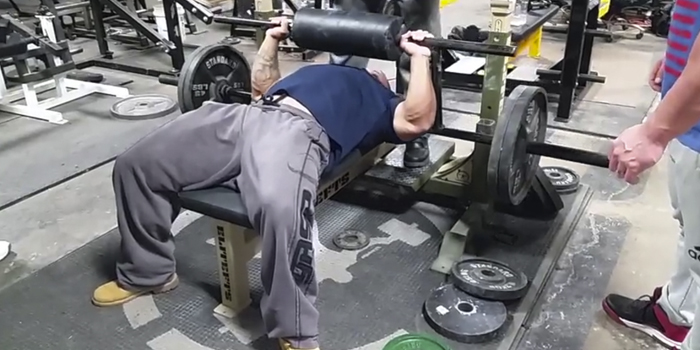
If there's one thing I've become big on as I've matured in the fitness industry, it's learning to train optimally, regardless of goals. Many roads lead to Rome, and the best road is often the least traveled. For this article, that road is the Cambered Squat Bar.
The Cambered Squat Bar is one unique barbell you can find at elitefts. Although it's less common than the Safety Squat Bar, it has a ton of benefits and ways you can implement it into your training, regardless of training goals.
Error: No videos found.
Make sure this is a valid channel ID and that the channel has videos available on youtube.com.
Cambered Squat Bar Benefits
Shoulder Friendly
To kick things off, one of the best aspects of the Cambered Squat Bar is it is relatively shoulder friendly. If you're dealing with a banged-up shoulder, have an injury you are nursing, or are just trying to put less wear and tear on your shoulder before bench day, this is an excellent fit.
While it's not as good as the Safety Squat Bar, it can allow for some relief for less mobile people and remove that repetitive strain and position that might lead to overuse or tendonitis issues.
Different Stimulus
While there is nothing inherently bad with a squat bar, beating a dead horse often is a surefire way to get frustrated, injured, or just burnt out. The Cambered Squat Bar places the bar lower than your normal squat bar, where the weights are likely around hip or belly button height. This position changes the physics of the exercise entirely. Usually, the weight being close to the hips would be a benefit, however, because of the oscillation and instability the camber provides, it forces you to stay tight and own your positioning throughout the movement.
Most lifters will have one if not two, main issues when they squat: pitching forward and tightness.
What does this bar help fix?
Pitching forward and tightness.
After running a training cycle using the Cambered Squat Bar, you can attack the hole faster, be more stable, and be less likely to pitch forward.
Versatility
The Cambered Squat Bar can be used on squats, good mornings, lunges, bench press, Zercher carries, overhead presses, and much more. Just about any movement you need to have slowed down, work on positioning, or challenge overall trunk stability while being brutally strong…the Cambered Squat Bar can fit the bill. I personally like using them for good mornings or loaded carries with wrestlers.
Program Implementation
Now for the fun part—figuring out how to implement it within your training.
The most important aspect of this, before you program it for yourself or your athletes, is to ensure you have a good reason to use it. It would not be wise to have 11-year-old Johnny use the cambered squat bar or 74-year-old Mary do loaded carries with it. We can find better exercises for these populations for their intended training goals (99% of the time, anyways). Typically you'll want these for more intermediate to advanced clients that already have some general strength training behind them and foundational movements understood by both clients and athletes alike.
Powerlifting
Let's get the obvious one out of the way. We know the conjugate system loves to use the ability to vary stimulus to improve training qualities. I really like the Cambered Squat Bar for box squats, good mornings, pause squats, and dynamic effort work with chains.
It can help teach lifters how to stay tight on the box, in the hole, or while keeping their upper back tight during good mornings. I know some lifters love it for bench press, and it's certainly challenging, but I've always liked the earthquake bar more. Nonetheless, it's great for teaching tightness with your bench press.
Hypertrophy
If I competed in bodybuilding, I would only squat with a Cambered Squat Bar or the Safety Squat Bar. There isn't a reason to place our shoulders in an externally rotated position more than we have to, especially since our goal would be merely leg size, not strength or technical mastery of the squat. Implement on any day you need to squat for a new challenge and to save your shoulders for chest day.
Sports Performance
As a coach who makes his living training athletes, I use this bar the most. I generally save it for upperclassmen and athletes I know love to be in the weight room and work hard, but also more advanced athletes that need some shoulder TLC (baseball, softball, swimming, tennis, volleyball). My favorite exercise for athletes are front rack split squats. We improve single-leg strength and power, improve trunk and upper back strength, and generally see improved hip stability. We also use them for loaded carries in a Zercher position for our wrestlers to work on upper back strength and mimic having to hold athletic positions. There are certainly many more, but these have been staples I see myself using quite frequently.
Final Thoughts
While the Cambered Squat Bar isn't one of the most popular pieces of equipment, it definitely should be. During your next training cycle, find a place to plug it in (justifiably), and give it a thorough run to improve your squat, deadlift, and bench press.
Your training and body will thank you.
Brandon Smitley is a 2011 graduate of Purdue University, where he earned his Bachelor’s degree in Health and Fitness, and of Indiana State University with his Master's Degree in Coaching. His best lifts to date are a 567-pound squat, 330-pound bench, 510-pound deadlift, and 1377-pound total in the 132-pound weight class! Brandon holds his CSCS, USAW, and CPT certifications. He has opened THIRST with his wife, Adrian, to help athletes and others realize their full potential from proper strength training methodologies.











2 Comments